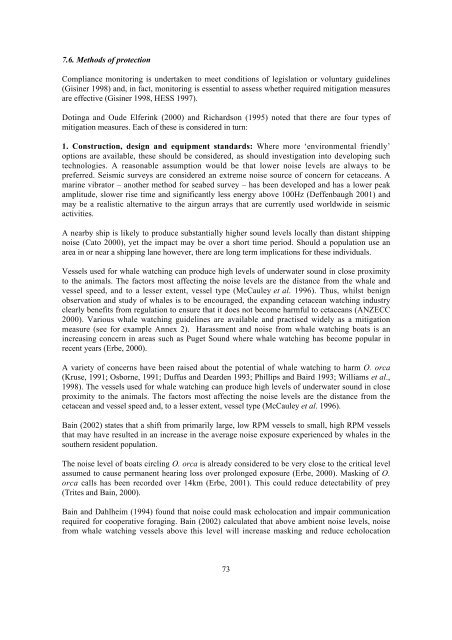Oceans of noise - Whale and Dolphin Conservation Society
Oceans of noise - Whale and Dolphin Conservation Society
Oceans of noise - Whale and Dolphin Conservation Society
You also want an ePaper? Increase the reach of your titles
YUMPU automatically turns print PDFs into web optimized ePapers that Google loves.
7.6. Methods <strong>of</strong> protection<br />
Compliance monitoring is undertaken to meet conditions <strong>of</strong> legislation or voluntary guidelines<br />
(Gisiner 1998) <strong>and</strong>, in fact, monitoring is essential to assess whether required mitigation measures<br />
are effective (Gisiner 1998, HESS 1997).<br />
Dotinga <strong>and</strong> Oude Elferink (2000) <strong>and</strong> Richardson (1995) noted that there are four types <strong>of</strong><br />
mitigation measures. Each <strong>of</strong> these is considered in turn:<br />
1. Construction, design <strong>and</strong> equipment st<strong>and</strong>ards: Where more ‘environmental friendly’<br />
options are available, these should be considered, as should investigation into developing such<br />
technologies. A reasonable assumption would be that lower <strong>noise</strong> levels are always to be<br />
preferred. Seismic surveys are considered an extreme <strong>noise</strong> source <strong>of</strong> concern for cetaceans. A<br />
marine vibrator – another method for seabed survey – has been developed <strong>and</strong> has a lower peak<br />
amplitude, slower rise time <strong>and</strong> significantly less energy above 100Hz (Deffenbaugh 2001) <strong>and</strong><br />
may be a realistic alternative to the airgun arrays that are currently used worldwide in seismic<br />
activities.<br />
A nearby ship is likely to produce substantially higher sound levels locally than distant shipping<br />
<strong>noise</strong> (Cato 2000), yet the impact may be over a short time period. Should a population use an<br />
area in or near a shipping lane however, there are long term implications for these individuals.<br />
Vessels used for whale watching can produce high levels <strong>of</strong> underwater sound in close proximity<br />
to the animals. The factors most affecting the <strong>noise</strong> levels are the distance from the whale <strong>and</strong><br />
vessel speed, <strong>and</strong> to a lesser extent, vessel type (McCauley et al. 1996). Thus, whilst benign<br />
observation <strong>and</strong> study <strong>of</strong> whales is to be encouraged, the exp<strong>and</strong>ing cetacean watching industry<br />
clearly benefits from regulation to ensure that it does not become harmful to cetaceans (ANZECC<br />
2000). Various whale watching guidelines are available <strong>and</strong> practised widely as a mitigation<br />
measure (see for example Annex 2). Harassment <strong>and</strong> <strong>noise</strong> from whale watching boats is an<br />
increasing concern in areas such as Puget Sound where whale watching has become popular in<br />
recent years (Erbe, 2000).<br />
A variety <strong>of</strong> concerns have been raised about the potential <strong>of</strong> whale watching to harm O. orca<br />
(Kruse, 1991; Osborne, 1991; Duffus <strong>and</strong> Dearden 1993; Phillips <strong>and</strong> Baird 1993; Williams et al.,<br />
1998). The vessels used for whale watching can produce high levels <strong>of</strong> underwater sound in close<br />
proximity to the animals. The factors most affecting the <strong>noise</strong> levels are the distance from the<br />
cetacean <strong>and</strong> vessel speed <strong>and</strong>, to a lesser extent, vessel type (McCauley et al. 1996).<br />
Bain (2002) states that a shift from primarily large, low RPM vessels to small, high RPM vessels<br />
that may have resulted in an increase in the average <strong>noise</strong> exposure experienced by whales in the<br />
southern resident population.<br />
The <strong>noise</strong> level <strong>of</strong> boats circling O. orca is already considered to be very close to the critical level<br />
assumed to cause permanent hearing loss over prolonged exposure (Erbe, 2000). Masking <strong>of</strong> O.<br />
orca calls has been recorded over 14km (Erbe, 2001). This could reduce detectability <strong>of</strong> prey<br />
(Trites <strong>and</strong> Bain, 2000).<br />
Bain <strong>and</strong> Dahlheim (1994) found that <strong>noise</strong> could mask echolocation <strong>and</strong> impair communication<br />
required for cooperative foraging. Bain (2002) calculated that above ambient <strong>noise</strong> levels, <strong>noise</strong><br />
from whale watching vessels above this level will increase masking <strong>and</strong> reduce echolocation<br />
73

















